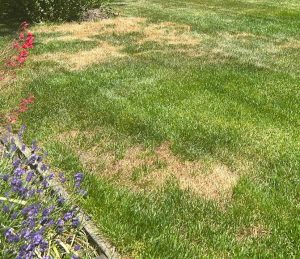Applying slow release fertiliser in the rain: What you need to know
When it comes to feeding your lawn, timing makes all the difference. It can seem logical to put fertiliser out before or during a bit of rain. After all, it saves you the job of watering it in. The problem is that unless it rains properly, applying fertiliser at the wrong time can do more harm than good.
The problem with damp foliage
If you put fertiliser on damp or wet grass, you risk fertiliser burn. Moisture triggers the release of the salts inside the granules, and if that happens while the fertiliser is sitting on the leaves instead of soaking into the soil, it can scorch the lawn. You might notice brown patches or a faded look in those areas a few days later.
Example: Granular fertiliser that’s been applied with incorrect irrigation requirements resulting in burn.

When rain helps and when it doesn’t
Light showers or passing drizzle aren’t enough to do the job. For the fertiliser to work safely, it needs to be watered in properly, the same as you’d do with irrigation. That means consistent, soaking rain that lasts long enough to reach the root zone. Anything short of that and you risk activating the fertiliser on the foliage, not in the soil.
Why irrigation volume matters
When fertiliser manufacturers run trials, they experiment with many different water volumes to see what gives the best results. So when the bag says to water in with 6-10 millimetres, that figure isn’t a guess. It’s based on extensive testing that shows how much water is needed to activate the nutrients properly and move them into the soil profile.
Rain is unpredictable, and that’s the problem. You might get too little and leave fertiliser sitting on the surface, or too much and wash valuable nutrients away. It’s very rare to get it exactly right with rainfall alone, which means you’re unlikely to get the full benefit from the product unless you follow the manufacturer’s irrigation recommendations.
The risk of leaching in heavy rain
Too much rain can be just as harmful as too little. When the soil becomes saturated, excess water can carry nutrients down past the root zone before your lawn has a chance to use them. This process is called leaching. It not only wastes fertiliser but also means your lawn misses out on the full benefit of the nutrients you’ve paid for.
Heavier or prolonged rain can also wash away uncoated or partially dissolved granules sitting on the surface, particularly on sloped lawns. That’s another reason to rely on controlled irrigation where possible, rather than hoping the weather will do it for you.
Coated fertilisers offer some protection
Some slow release fertilisers use a polymer or resin coating that helps control how nutrients are released. While that reduces the risk of burn, it doesn’t completely remove it. Even with coated products, applying fertiliser to damp lawns or during light rain isn’t a good idea.
The best approach
We often see people in the Facebook group say things like, “Nah, she’ll be right, I do it all the time.” A few even suggest just covering your spreader and carrying on in the rain.
A couple of things about that. First, your spreader takes a beating when fertiliser gets wet. It clumps up, blocks the mechanism, and before long the machine starts to corrode or jam, not ideal if you want your gear to last.
Second, while it might go fine some of the time, there will be times when it doesn’t. For the wider audience, it’s not good practice. What might work for one or two people doesn’t make it reliable advice for everyone else. The manufacturer’s recommendations exist for a reason, and the best approach is simple: apply fertiliser to dry lawns and water it in properly. Doing it right not only protects your lawn, it also ensures you get the full value out of the bag, with performance that isn’t compromised by error, or by incorrect, over, or under-watering.
Is this the same for all NZLA Products?
We are not fans of relying on rain for any of our products. For most fertilisers or treatments that need watering in, we always prefer to do it manually rather than depend on the weather, this way it’s more controlled. The only exception is liquid wetting agent.
If the timing is right and heavy rain happens to line up with when we are due to apply a wetting agent, we will often take advantage of it. Most of the time we still water our wetting agent in ourselves, but if it is absolutely pouring, we will sometimes get the gear on and get out there. In those conditions, the rain helps move it deep into the soil profile quickly and evenly. That is the only product where we will intentionally apply during rain. Anything else, even light rain, carries too much risk of burn or uneven results.
Need help choosing a granular fertiliser? Check out the NZLA professional lawn range here.
Comments
0